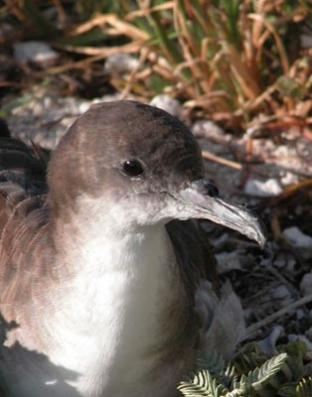Published in the Ocean Watch column, Honolulu Star-Advertiser © Susan Scott
September 20, 2010
 Fall is the season of the shearwaters, and this fall these native seabirds are getting the attention they deserve. After being sued by an environmental group, Kauai County officials recently agreed to work toward helping the endangered shearwater species, ao, or Newell’s shearwater (pictured). About 75 percent of these seabirds nest on Kauai; most others nest on the Big Island. The endangered, endemic Newell’s shearwater nests only in the Hawaiian Islands, digging burrows on fern-covered mountain slopes, usually at the base of trees.
Fall is the season of the shearwaters, and this fall these native seabirds are getting the attention they deserve. After being sued by an environmental group, Kauai County officials recently agreed to work toward helping the endangered shearwater species, ao, or Newell’s shearwater (pictured). About 75 percent of these seabirds nest on Kauai; most others nest on the Big Island. The endangered, endemic Newell’s shearwater nests only in the Hawaiian Islands, digging burrows on fern-covered mountain slopes, usually at the base of trees.
But Kauai’s numbers have been declining. In the early 1990s the worldwide population estimate of Newell’s shearwaters was about 84,000. In 2005 the count was less than 30,000.
Help from Kauai County includes money to organizations working to save the seabirds, record-keeping of dead and injured birds and plans to modify lighting systems, particularly in football stadiums in the fall.
Shearwater fledglings normally take their first flight from their nests to sea at night, using starlight and moonlight as guides. Bright lights, though, often cause the chicks to head inland where they hit power lines, building and cars. Some birds are stunned and need a helping hand; others die from the accidents.
Oahu and its surrounding islets host two other species of shearwaters. Small numbers of Christmas shearwaters nest on several Oahu islets, but the most common here by far is the wedge-tailed shearwater, a seabird beautiful to behold, with smoke-gray feathers above and gray-white feathers below. To know wedgies, as these birds are affectionately nicknamed, is to love wedgies. The seabirds have natural smiles on their beaks and are as sweet-natured as they look.
Wedge-tailed shearwaters are found throughout the subtropical and tropical Pacific and Indian oceans, soaring remarkably close to the surface in their search for fish and squid.
On Oahu the birds nest among rocks and in burrows at the Freeman Seabird Preserve on Black Point, at Kaena Point and in other places where they can burrow deep enough to be inaccessible to cats, dogs and mongooses.
Shearwater nesting season in Hawaii begins in March and April when the parents come to land to lay an egg and raise a chick. The youngsters leave their nests in October, November and December, and this first flight is everything. If they survive the launch and find enough food to survive, the birds remain at sea until they reach maturity at 6 to 7 years old. Then nature calls them ashore to start the next generation of shearwaters.
We can help Hawaii’s shearwaters in the following ways:
- Never, ever take a shearwater chick from its nest or from near its nest. If you find a shearwater fledgling on a beach in October, November or December, leave it there to find its own way to sea.
- The Kauai Humane Society has a good website — Shearwater Rescue — that offers shearwater handling guidelines. Only Kauai has multiple shearwater drop-off stations. On Oahu, if you find a bird inland, gently place it in a cardboard box and take it to the back of the parking lot behind Sea Life Park where you will see a drop-off spot, open 24/7.
- Fill out the form provided as to when, where and by whom the bird was found. In this way, wildlife officials can assess the scope of the problem.
- Help the birds as well as the dedicated seabird lovers at Sea Life Park by volunteering for their seabird program. Call Stephanie Flood at 259-2512. If you do this, though, be prepared. Once you get to know a shearwater, you’ll be in love for life.